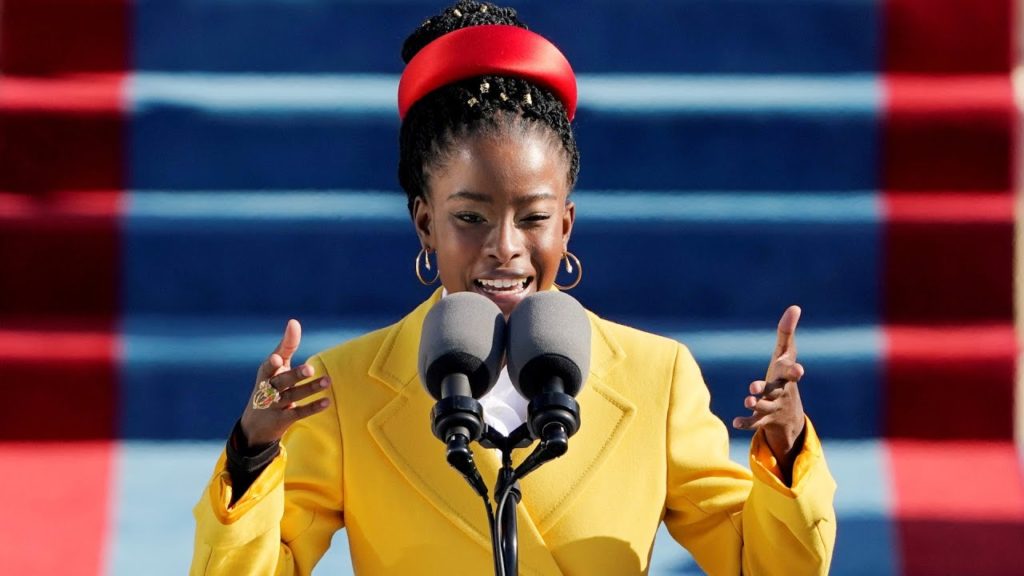

Heather Lawford, Bishop’s University; Heather L. Ramey, Brock University, and Jessica Riddell, Bishop’s University
National youth poet laureate Amanda Gorman’s recitation of “The Hill We Climb,” at Joe Biden’s presidential inauguration in the United States captured the attention of a nation and people globally.
Gorman highlighted the power of poets in our current sociopolitical context to speak unique and timely truths while tapping into larger literary traditions. Some commentators were reminded of the legacy of Black women poets like Maya Angelou and Elizabeth Alexander who delivered inaugural poems respectively at Bill Clinton’s and Barack Obama’s inaugurations. The ring Gorman wore was a tribute to Maya Angelou and a gift from Oprah Winfrey.
Gorman inspired people of all ages with the notion of seeing and being light. The day after the inauguration two of her books topped Amazon’s bestseller list.
Gorman moved many in a time of geopolitical uncertainty and a pandemic with the power of critical hope, something that combats hollow positivity. In the words of educator and literary theorist Ira Shor, critical hope asks us to “challenge the actual in the name of the possible.”
We are researchers who have studied how youth carve out legacies and how storytelling can teach and inspire critical hope. What struck us in hearing Gorman speak was how, at the age of 22, the poet taps into the power of generativity, a concept that refers to creating a legacy that lasts beyond our lifetimes to shape future generations.
As she recited: “But one thing is certain: If we merge mercy with might, and might with right, then love becomes our legacy and change our children’s birthright.…”
Shaping who we are by the stories we tell
Research repeatedly indicates that adults in their 30s and 40s who are involved in creating something that will last beyond their lifetime enjoy a better quality of life until death in many ways.
(Parenting, teaching, social justice activism, or engaging in creative projects are ways of leaving one’s mark in the world after death.)
Can people in their early 20s already see themselves carving out a legacy? Gorman’s poem suggests the answer is yes. She reminds people that what they do (or don’t do) will shape the legacy future generations inherit: “We will not be turned around or interrupted by intimidation because we know our inaction and inertia will be the inheritance of the next generation.”
Gorman’s poem speaks to the creative and leadership potential of youth. Her display of being part of a lasting legacy resonates with our experiences and some of our research.
Psychologist Erik Erikson popularized the idea that in middle age many adults become interested in leaving a legacy, but studies have found that many youths are also interested in creating something that lasts beyond their lifetime.
Research in literature and the meaning of narrative reveals how narrative shapes our relationship to the world around us.
Read more:
What we don’t understand about young people’s motivations
Highly generative adults also tend to tell stories about their lives using what some psychologists call redemptive themes: a story with a negative beginning gains meaning through a positive outcome.
We are currently studying the life stories of 18- to 24-year-olds who have been nominated by community leaders as young people who have made lasting impacts. The young people in our study have received awards, represented Canada on international stages, and founded organizations for social justice. Our research seeks to understand the relationship of their achievements to storytelling and identity formation, and how these both inform legacy building.
In both the fields of psychology and literary studies, we are fascinated with how narratives shape our relationship to our present and inform social change.
Redemptive themes
The theme of redemption, like the presence of generativity, infuses passages in “The Hill We Climb” in both communal and personal references. As Gorman read:
“[with] Every breath from my bronze-pounded chest, we will raise this wounded world into a wondrous one.”
Gorman’s recitation also carved out a redemptive moment by reclaiming the Capitol steps where a violent insurrection occurred only two weeks before. Those involved opposed the democratic electoral process and the crowd was populated with signs, symbols, and flags of white supremacist and extremist groups.

One day after the inauguration, National Guard troops continue to be deployed around the Capitol, in Washington, Jan. 21, 2021.
(AP Photo/Rebecca Blackwell)
By inviting her audience to envision future acts of “hope and light” on those steps, she joined this event, its larger histories, and its cultural and political contexts to a meaningful and optimistic shared experience. When she spoke, no divisions were erased, but she acknowledged the possibility that together we can create a world that is better, more equitable, and just.
Such a redemptive capacity is found in adults who show a strong commitment to legacy building. It is also what we as researchers are looking for in our study of young leaders.
Journey through generations
Gorman is aware that she represents the living legacy shaped by those who came before her and that her legacy belongs to future generations. She told CNN she has a mantra she recites when she performs:
“I’m the daughter of Black writers. We’re descended from freedom fighters who broke their chains and changed the world. They call me.”
Examining youth voice teaches us that generativity is about understanding the redemptive journey through generations, and one’s role within the larger picture.
Psychologists have long connected the importance of sharing family stories at the dinner table and even outlined how through a story, parents, and grandparents uniquely contribute to a child’s values and moral development.
These connections also occur through outside forces like mentors, advocates, and youth programs that nurture talent and the capacity to thrive.
Gorman’s journey illustrates the transformative power of intergenerational collaborations documented in research. Gorman acknowledged: “I say I am proud of us because this really takes a village, I have so many supporters [and] so many organizations … have supported me ….”
Oprah Winfrey tweeted about her pride at seeing a “young woman rise.” Gorman told the Associated Press it was Jill Biden who recommended her for the inaugural occasion.

The Skylight Book store in the Los Feliz neighborhood of Los Angeles is decorated with a poster of Gorman, Jan. 25, 2021.
As researchers who work with young people every day, youth inspire us to hope more and think bigger. Gorman is part of a generation of young leaders, such as Malala Yousafzai, Greta Thunberg, and gun reform activist David Hogg who deserve support and commitment from those around them to create space for youth generativity in education, government, community, sports, and in the arts.
Gorman ends her poem with encouragement to begin our own journeys of critical hope:
“For there is always light, if only we’re brave enough to see it. If only we’re brave enough to be it.”
Heather Lawford, Professor, Department of Psychology and Canada Research Chair in Youth Development, Bishop’s University; Heather L. Ramey, Assistant Professor, Child & Youth Studies, Brock University, and Jessica Riddell, Full Professor and Jarislowsky Chair of Undergraduate Teaching Excellence, Bishop’s University
This article is republished from The Conversation under a Creative Commons license. Read the original article.




1 Comment
Pingback: bass type beat